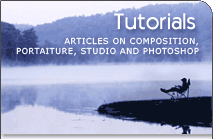Weather and Time of Day
Here is another page with my blether where I will try to share my thoughts on how weather and time of the day may affect the photograph and, of course, how to use it in expressing mood and creating some special effects.
Time Of Day
Usually people divide the day in the following sections: Night, Morning, Midday, Afternoon and Evening. Each of these parts of the day has their own effects on the quality of light and mood. You may say that some of them don't have any light (such as night time), but actually the light just changed from natural to artificial - like the street lights. Let's briefly review each of these parts of day.
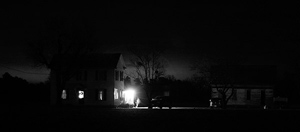
Night - first of all we cannot take pictures without a tripod (or a monopod), because the required shutter speed is slow - from 1/30 of second to even several minutes (or hours). People and moving objects usually appear as a blurred/smudged streak of light or shape. And actually it's kind of nice - we can express motion in a photograph by the contrast of sharp (in focus) shapes and blurred or smudged (sometimes almost unrecognizable) shapes.
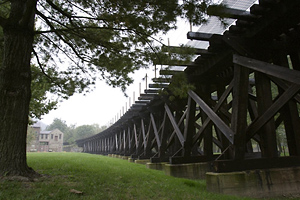
Morning - One of my favorit times of the day. The sun is low and shadows could be very pleasant in the photograph. And if you make portraits you may achieve a great modeling light for you photographs. The color of the light is warm and slightly reddish, which is another reason to use such an opportunity in your photographs
Midday - The sun is in its zenith, the shadows are very short and very dark. It's very hard to avoid those black holes under any subject (and eye-brows as well). These shadows and searing sun make the subject appear the least appealing and kind of flat. Usually it's not recommended to take pictures during this time of the day. Except the light is good for textures, such as walls or other vertical objects, when the shadows increase the sense of the surface. In anyway, it's better to use a reflector or any other fill-in light.
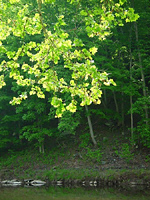
Afternoon - Sun is getting a bit lower and shadows become longer, but the quality of light doesn't change much from the harsh midday sun. You may use the light when the sun about 45 degrees from the horizon, which could be nice for certain shots. It could be a nice time for street photography (not the best though), when the crowd is out in the open and there are many opportunities to take a good shot.
Evening - Another great time of the day when the sun is getting lower and lower with every minute. And even after the sunset there are few minutes, when the light of the sky creates somewhat magic mood. Or when blue sky turn into bright deep blue, which could be the right moment to take photographs with the moon in the frame - not too bright, and just enough contrast to fit in the dynamic range of the film or digital chip.
~ Top ~Sunrise vs. Sunset
Sunrise and sunset are two best parts of the day when a real photographer can use the full advantage of the natural light. But even the angle of the sun is the same during those periods of time, these periods has their own advantages and disadvantages. Though I would not separate them so radically, better to say that some people may like different qualities/traits of those times of the day and thus prefer sunset to sunrise or vice versa. Let's talk about it in details (known to me).
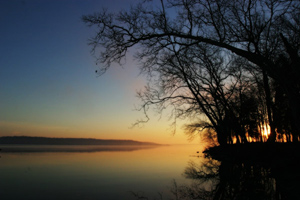
As I have already mentioned the sun is low and because the light has to come through thick layers of atmosphere, it changes its color and diffusion qualities. The color is more reddish and yellowish, which makes the objects look warmer and sometimes more attractive. The better diffusion of the light makes the shadows with more gradient edges and the transition from light to shadow becomes sometimes less evident. The same diffusion effect happens in much stronger form on a cloudy day, when the clouds play a role of a huge diffuser in front of the light source. The shadows during sunrise and sunset are long and you may find it interesting just to base the photograph purely on the shadows, their pattern. Or use them as leading/converging lines to bring the eye to the subject, which casts them.
Sunrise is a time of the day when the ground is getting warmer, so there is no haze (or very little) in the sky. On opposite to sunset, when during the day the vapors along with stirred dust fill the air and "smudge" the sky. Some consider such quality of the sky to be a nice thing, but I prefer the clear bright blue sky, so when I use a polarizer the sky stands out in the picture increasing the impact of the photograph.
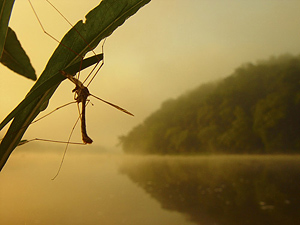 During the night most of the living things go to sleep and at sunrise the stillness is still there, you easily can take a photograph of some bug or other living creature. During sunset it's much harder to catch a moment when the same bug would stop, so you would get a sharp focus of it.
During the night most of the living things go to sleep and at sunrise the stillness is still there, you easily can take a photograph of some bug or other living creature. During sunset it's much harder to catch a moment when the same bug would stop, so you would get a sharp focus of it.
The same is true about people. Rarely do you see a person wandering around even at a very popular sight seeing site. On contrary at sunset you will find a crowd at the same site, and there will be no way to get the picture without people in it. And again, it's up to you whether you want to include people in the frame or not, as well as the time of the day to choose for such a picture.
In relation to people I may say something about traffic on roads. If it requires driving a couple or more of hours to get at your destination and you live in a city or suburbs, it's much easier to get there and come back in the early morning, than to share the road with thousands of other drivers in the evening.
Another thing I like about morning trips is that the day is just starting and you are not limited by few minutes of the sunrise, the whole day is ahead of you. When the sunset comes the darkness envelopes the place and you have to go home (unless you are in a city and have a tripod for low light scenes).
But with sunset shootings you don't have to distort your way of life and try to open your eyes somewhere in the middle of the night. Though a cup of coffee usually fixes the situation, however the body completely wakes up when it sees the sunlight (it is some biological mechanism). And usually at sunrise it gets too hectic to find the right spot and catch the quickly changing light, because before it was dark and you cannot evaluate the place very well prior to the shooting. Fortunately, when you often visit the same places you getting to know good spots and envision effects of different light situations, so you don't end up completely blind in choosing the spot.
~ Top ~Night & Low Light
It seems that when sun went to sleep there is not much to take pictures of and usually requires certain skills and equipment to make a good photograph. Well, let's try to see how we can work in such case. First of all we can use flash to add 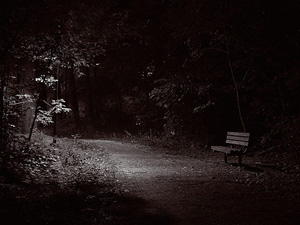 artificial light when and where we need it most, but even so such solution has its limits and drawbacks: the flash will lit only the subject and a little bit around you, the objects in the photograph will seem flat because even off-camera flash will not give you the modeling light or natural diffused light. What next? If you have light stands and a lot of power to make your own studio - there are no reasons to not use it, but why should you move it outside? Well, I was kidding.
artificial light when and where we need it most, but even so such solution has its limits and drawbacks: the flash will lit only the subject and a little bit around you, the objects in the photograph will seem flat because even off-camera flash will not give you the modeling light or natural diffused light. What next? If you have light stands and a lot of power to make your own studio - there are no reasons to not use it, but why should you move it outside? Well, I was kidding.
So there still left one great possibility to make pictures in the low light - use whatever light you have and a tripod. You will be surprised to see what you can get by using just one tripod. If you notice, when the night fallsб the city becomes something different, something you've never seen.
Recently I walked through Washington in the night, and it seemed that the city has a new face. The shadows and light from open and hidden lamps or windows created new patterns and gradual diminishing of light added another dimension to my perception.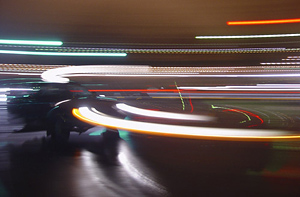 We just to have to let our minds to see and appreciate it.
We just to have to let our minds to see and appreciate it.
And there even one more dimension that actually the camera sees. Because the low light conditions require more time to make a proper exposure, moving objects introduce sense of motion. It really nice to use such blurred in your photographs. You have must seen those photographs with rivers of red and white light that are roads in real life. This effect is based on simple rule that the body of a moving car reflects almost no light, in opposite the head-lights and tail-light are the only bright points of the car, which will be captured by the camera.
You know that when you follow the moving your subject with the camera during its movement it is called panning. And such technique can help you to produce strange and abstract images (as you can see above). This photograph I've taken by holding the camera standing on a monopod and moving it to follow the moving car, which was making a turn at an intersection. The shutter speed was somewhere between 1/2 and 2 seconds.
~ Top ~Sunny & Cloudy
Such conditions are very usual, though there some interesting moment, which you should know and use for your own benefit. One of them is that clouds are a natural giant diffuser that make the light soft, so the sun with the clouds plays as a huge softbox. 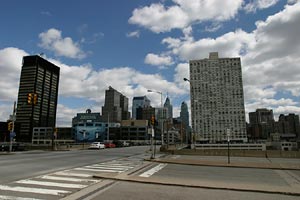 The main feature of such a softbox is that the shadows lose their sharpness and prominence; they don't appear anymore as black holes. The light envelopes objects and pours into the shadows. The thicker the clouds the softer the shadows, and sometimes the shadows just almost disappear.
The main feature of such a softbox is that the shadows lose their sharpness and prominence; they don't appear anymore as black holes. The light envelopes objects and pours into the shadows. The thicker the clouds the softer the shadows, and sometimes the shadows just almost disappear.
This effect could be effectively used when the sky covered with sparse clouds, so the wind sometimes move them in front of the sun (turning them into a huge diffuser) or reveals the sun again (increasing the contrast and saturation of colors). It means that only a short time separates these two different lighting conditions, and you should not come twice at the same place to observe it under different light. And when you take pictures of people it as well is a great to have such a sunny background, which is a rare thing in a cloudy day. Even if you use a shade from a tree or a building it still can block some of the background.
~ Top ~Fog, Rain and Snow
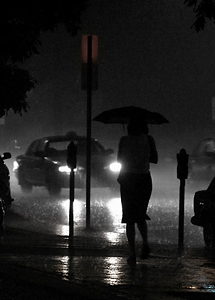 Regular people don't like such weather conditions and prefer to spend some quality time at home or among friends. It's always nice to sit in close circle of friends or relatives and enjoy warm conversation, meanwhile the snow blizzard goes wild outside or pouring rain drowns sidewalks and cars. But if you think of it, there are some few photographs of people in rain or in snow, or any other subjects, for that matter. You can always find a good many pictures in bright sunny day and almost none in rain or snow or fog.
Regular people don't like such weather conditions and prefer to spend some quality time at home or among friends. It's always nice to sit in close circle of friends or relatives and enjoy warm conversation, meanwhile the snow blizzard goes wild outside or pouring rain drowns sidewalks and cars. But if you think of it, there are some few photographs of people in rain or in snow, or any other subjects, for that matter. You can always find a good many pictures in bright sunny day and almost none in rain or snow or fog.
And such attitude is a huge mistake many people do when they hide from the weather inside. The photographs of these types of weather are always attractive and it's so easy to express mood with rain, fog or snow.
Fog, for example, adds a three-dimensional feeling to the photographs. The background is disappearing in the haze while the foreground is still fully visible and the thicker the fog, the stronger the effect. Here is an interesting article about Fog and Backlight to create mood in photographs.
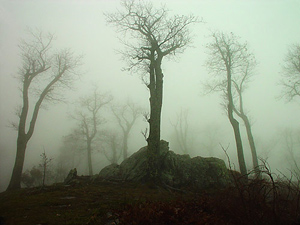 Rain is rich with its reflections on the water and as fog adds some depth to the photographs. People caught in rain behave differently and it is easy to find a great moment, when they jump over the puddles or shrink under the umbrellas.
Rain is rich with its reflections on the water and as fog adds some depth to the photographs. People caught in rain behave differently and it is easy to find a great moment, when they jump over the puddles or shrink under the umbrellas.
Snow with its flurries covers the ground without a sound and make everything white and new. It seems that everything is slowing down and almost stops. Sounds are diffused and distant in snowfall. And the world becomes something different that it was earlier, as though we discover it again.
There is one more good feature of this type of weather - it doesn't matter is it an early morning or midday - the sky is covered with thick clouds and you can easily sleep till noon and only then go anywhere. Isn't it great? :)
~ Top ~Seasons
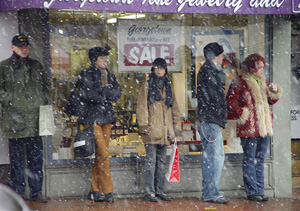 Each season has its own beauty, even it's cold and wet and sleet covers the ground, you can find beautiful moments of the season. It could be the vibrant colors of leafs on trees, or stark silhouettes of branches against a rising sun, or a forest totally covered with ice. Or a first snowdrop flowers among patches of snow.
Each season has its own beauty, even it's cold and wet and sleet covers the ground, you can find beautiful moments of the season. It could be the vibrant colors of leafs on trees, or stark silhouettes of branches against a rising sun, or a forest totally covered with ice. Or a first snowdrop flowers among patches of snow.
As a photographer (amateur or professional) you should love to see and should be proficient in this, so open your eyes and enjoy the beauty of the world around us. It could be small or huge, dark or bright, sad or joyful, glum or bright... ![End of the article [end of the text]](http://www.romanzolin.com/img/misc/text_end.png)
